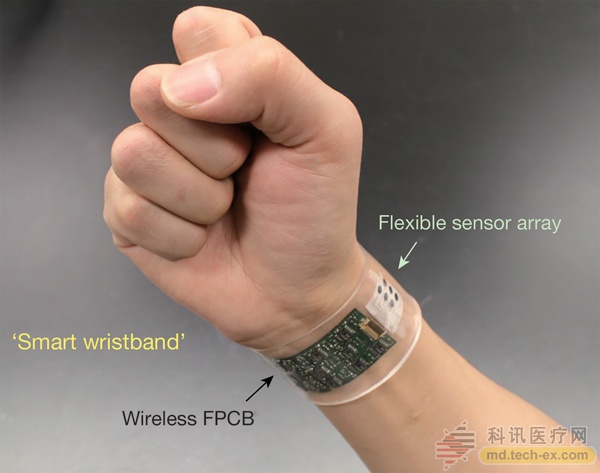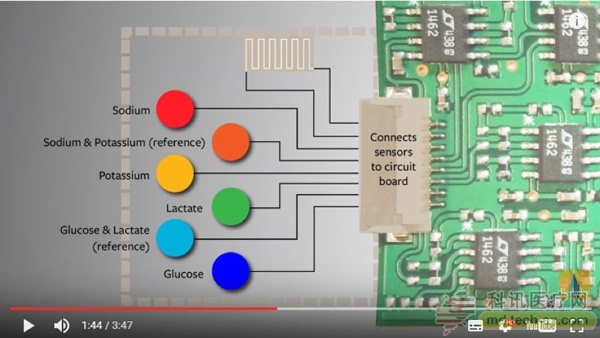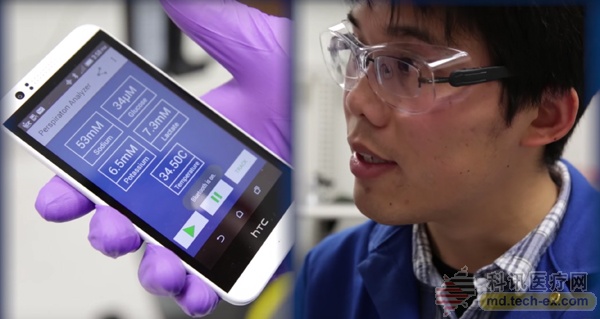Release date: 2016-10-10 Previously, Dr. Gao Wei, a postdoctoral fellow at the University of California, Berkeley, had an idea: If there is a sensor that can detect the daily health of the human body, then people can keep abreast of their health problems. Gao Wei, who was in his early 30s, grew up in the rural area of ​​Xuzhou. He experienced a sudden death and was a cerebral thrombosis. He didn't know anyone at night and died a few months later. Now, he is witnessing the idea becoming a reality, and the fully flexible sweat sensor developed by him is available. This wearable sensor is shaped like a sweat-absorbent belt, and is equipped with a Bluetooth-equipped printed circuit board, 5 sensors with a diameter of 3 mm, a lithium battery that can support 10 hours of use, and body information by detecting sweat. And wirelessly transfer the data to the app on the phone. In August, the MIT Science and Technology Review's annual Young Heroes list was announced. Gao Wei was selected as one of the six Chinese on the list with this sweat sensor. Gao Wei Every year, 35 "World Outstanding Young Innovators" over the age of 35 are selected on the list. Gao Wei's postdoctoral tutor Ali Javey was one of the finalists seven years ago. This year, Ali Javey nominated Gao Wei to the MIT Technology Review. Gao Wei said that many of his idols in academia and science and technology have been on the list, and now he has added this award to his resume. After completing his studies at Huazhong University of Science and Technology and Tsinghua University, Gao Wei went to the University of California, San Diego to study for a Ph.D., and in 2014, he began his postdoctoral research at Berkeley, California. From this time, he began to use sweat sensors as research directions. Wearable sweat sensor Wearable sensors are becoming a trend, and Gao Wei also believes that it will play a pivotal role in personalized medical care in the future. However, unlike the sensors on the market that detect physical activity and life characteristics such as heart rate and body temperature, Gao Wei told the news () that the biggest highlight of this sweat sensor is to detect health from the molecular level. In other words, the content of chemical components in human body fluids is used to reflect vital signs. a few microliters of sweat, non-invasive detection of disease It is very common to use body fluids to detect physical conditions. Most hospital tests rely on various body fluids. But Gao Wei's idea is daily, no need to go to the hospital for testing, which means that non-invasive testing is preferred. In this way, blood with body information is excluded, and obtaining blood means that there is a wound, which is not practical for daily real-time detection. In addition, what other body fluids, carrying a lot of life information, and easy to obtain? Gao Wei saw the possibility of sweat. The chemical composition of sweat is diverse and easy to obtain. In the initial version of the sweat sensor, Gao Wei set five detection dimensions: glucose, lactic acid, sodium ion, potassium ion and body surface temperature, and also continuously added heavy metal, chloride ion and other detection objects. These specific test subjects can peek into the secrets of the body. Gao Wei said that it is already medically convinced that sodium ions in the blood can detect the dehydration of the body, and chloride ions can be used to diagnose cystic fibrosis. Glucose in the human body is associated with glucose in the blood and can be used to detect diabetes. But Gao Wei admits that sweat is not a body fluid that has been studied on a large scale. There are still many unknown things. Although the trend is optimistic, it takes more time. On the one hand, the connection between sweat and blood in various components needs to be confirmed by a large number of clinical trials. On the other hand, sweat may be a rich mineral of life information, and more detection dimensions have yet to be developed. "What we have researched is a platform that can be used for different products, whether it is more or fewer sensors, or different sensors, and we expect that it will eventually be implemented on this platform." Gao Wei said. Used to detect multiple life data, how much sweat does the sensor need to maintain a stable reading? Gao Wei said that the sensor only needs a few microliters of sweat, which is equivalent to one tenth of a drop of water in a normal dropper, so that five sensors can work together and work together. A few microliters of sweat is not difficult for the human body in motion. At present, Gao Wei and his colleagues also mainly locate the sweat sensor in the scene when people exercise. However, if it is in a static and not easy to sweat environment, Gao Wei also thinks about the solution. On the one hand, the scale of the sensor is further reduced to the micron level, so that the amount of sweat required will be reduced accordingly. On the other hand, it can be passed. The artificial method makes people sweat. Gao Wei told 澎湃News that artificial sweating is a kind of drug that is harmless to the human body in the United States. It uses current to inject the drug into the surface of the skin, thus causing sweat on the surface of the skin. Fully flexible system, collecting 5000 data per second The information monitored by the sensor is ultimately presented as data. Specifically, the working principle of the sensor is different for different detection objects. Glucose and lactic acid are current sensors based on catalytic enzymes. When the concentration of glucose and lactic acid in sweat increases, the current will increase accordingly. Unlike sodium ions, which are voltage sensors, the magnitude of the voltage output is proportional to the logarithm of the two ion concentrations in the sweat. Sweat sensor construction. University of California, Berkeley After the generated current, voltage, etc. are amplified and filtered by the circuit, it will reach the microcontroller of the sweat sensor, which is equivalent to the "brain" part for data processing. The processed data is sent to the mobile APP via the Bluetooth device, and the contents of each electrolyte, metabolite, and concentration are displayed on the screen in real time. Wirelessly transfer data to your phone via Bluetooth. University of California, Berkeley "It's very important to make this system that it can be worn on the human body very comfortably and provide very stable readings." Gao Wei admits that this is also the biggest difficulty in designing wearable sensors. To this end, Gao Wei gradually clears two key words in the process of optimization: flexibility and calibration. At the beginning, Gao Wei made the sensor into a flexible material, which was relatively easy. Later, it also solved the problem of flexible circuit board and realized the flexibility of the whole system. In this way, the integrated wristband can be like a sweatband, forming a curvature and a more conformable skin. The benefits of flexible materials are not only more comfortable to wear, but also better contact with the skin and also provide reliable data. Calibration is “safeguarding†the accuracy of the data. The so-called calibration refers to the “mutual help†between different sensors, providing different information to ensure that the data displayed on the screen of the mobile phone is in line with the actual situation. Temperature sensors play an important role in calibration, such as the same 100 micromoles of glucose. As the body surface temperature rises, the current level of the glucose sensor changes. Without the corresponding body surface temperature, the actual glucose content cannot be converted based on the current. "Your body surface temperature can be very large, right? If you are in the tropics or in the North Pole, this is definitely not the same." Gao Wei said that in addition to calibration, temperature sensors can also be used for certain skin disease characterization. Detection. Despite the small size, the sweat sensor collects data in large quantities and quickly. Gao Wei told 澎湃News that each sensor generates 1000 data per second, and the sweat sensor that works with 5 sensors is 5000 data, but in the actual mobile phone screen display, it is based on the data update rate once per second. . It is worth mentioning that each data generated by the microcontroller is an average of all values ​​in a fixed unit time. For example, the data generated in 1.1 seconds is the average of 1000 data between 0.1 seconds and 1.1 seconds. In addition to the average method, Gao Wei also performs low-peak filtering on the current, taking only the DC part to eliminate the interference of the human body's own noise (AC). The purpose of doing this, Gao Wei said, is to make the data curve that is finally presented to the user smoother and more accurate, and reduce the fluctuation of environmental noise on the data. In January of this year, Gao Wei was the first author and the paper on this all-flexible sweat sensor was published in the international journal Nature, which is the forerunner in the field. After that, many companies and venture capitalists came to talk about cooperation, but Gao Wei and instructor Ali Javey chose to optimize first and then talk about commercialization. “We want to further improve the equipment to provide more reliable readings under various conditions. On the other hand, we are doing a lot of human experiments and hope that our sensors can have more useful uses.†Source: 澎湃News
Monkeypox is a viral zoonosis (a virus transmitted tohumans from animals)with symptoms very similar tothose seen in the past in smallpox patients, typically- presents clinically with fever, rash and swollen lymphnodes and may lead to a range of medical complications.It is caused by the monkeypox virus which belongs toIt is caused by the monkeypox virus which belongs toare two clades of monkeypox virus:the West Africanclade and the Congo Basin (Central African) clade.Theoname monkeypoxoriginates from the initial discovery ofthe virus in monkeys in a Danish laboratory in 1958.Thefirst human case was identified in a child in the Demo-cratic Republic of the Congo in 1970.
The Antigen test set is based on immunoch-romatographic and use double-antibodyromatographic and use double-antibodyromatographic and use double-antibodyromatographic and use double-antibodyromatographic and use double-antibodyromatographic and use double-antibodyphy, the complexes move forward along thenitrocellulose membrane till captured bypre-coated monoclonal antibody ofpre-coated monoclonal antibody ofinterprete the test results.
Rapid Test Kit,Easy-to-use disposable kit,Antigen Rapid Detection Kit PCR Assay Kit,Nasopharyngeal swab Jiangsu iiLO Biotechnology Co., Ltd. , https://www.sjiilobiotech.com


